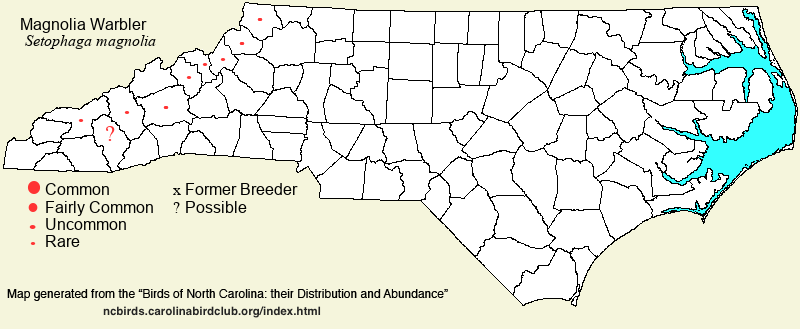 |  |
|
Magnolia Warbler - Setophaga magnolia PARULIDAE Members: | Search Common: Search Scientific: |
|
|
|||||||
| General Comments | The Magnolia Warbler nests across most of the boreal forest zone of Canada and the northeastern states. Until a few decades ago, the southern end of its breeding range stopped in Virginia; but since the 1980's, the species started to appear in younger spruce-fir stands in the North Carolina mountains. Now, Magnolia Warblers are present in very small numbers in most of the ranges and isolated mountains that contain spruce-fir stands, though the birds inhabit edges of such forests, young to middle-aged stands, and openings in such forests. Breeding evidence has been somewhat skimpy, though adults have been seen feeding young out of the nest; no nest has yet been found in the state. Actually, Magnolia Warblers may have nested sparingly in the mountains in the 19th Century and in the early decades of the 20th Century. The species is a rather numerous migrant in the mountains and Piedmont, but it is scarce toward the coast (except in fall). As with most warbler species, migrant individuals are normally seen away from conifers and are seen mostly in the canopy or mid-story of hardwood forests and edges. | ||||||
| Breeding Status | Breeder | ||||||
| NC BRC List | Definitive | ||||||
| State Status | SR | ||||||
| U.S. Status | |||||||
| State Rank | S2B | ||||||
| Global Rank | G5 | ||||||
| Coastal Plain | Transient. In spring, rare to uncommon in the western portions, rare over central portions, and very rare to at times rare close to the coast. In fall, uncommon to at times fairly common (after a cold front) over most of the region, including the coast. Mainly early to late May, and early Sep to mid-Oct. One about 30 miles off Cape Hatteras (Dare) on a 14 May 2023 pelagic trip was most unusual. There are three reports in Nov, including one for 25 Nov and another for 27 Nov. Peak counts: | ||||||
| Piedmont | Transient. Mainly uncommon in spring, and fairly common in fall, over most of the province. Clearly more numerous everywhere in fall than in spring. Mainly early to late May, and late Aug to mid-Oct. Peak counts: | ||||||
| Mountains | Scarce summer resident (at higher elevations), and transient. In summer, rare to locally uncommon in most areas of spruce-fir, south to and including Great Smoky Mountains NP; essentially over 5,000 feet, but occurs in Long Hope Valley (Watauga and Ashe) at 4,300 feet. In summer 2023, lower elevation singing birds were reported from Banner Elk (Avery) on 17 Jun and in northwestern Ashe on 12 Jul. Only a few actual breeding records have been documented. Elsewhere, generally uncommon spring migrant, and common in fall. Mostly early May to late May, and mid-Aug to mid-Oct. One photographed at Beaver Lake (Buncombe) from 7-25 Nov 2016 was remarkably late. Peak counts: in summer, up to 8 males at Roan Mountain (Mitchell), 5 Jun - 16 Jul 2013. | ||||||
| Finding Tips |
It usually can be found in fall migration in the mountains, in various parks and along the Blue Ridge Parkway; however, as with birds in migration, numbers can be spotty from day to day. In summer, the best areas are Roan Mountain (such as near the Rhododendron Gardens) and Mount Mitchell SP. *** | ||||||
| Attribution | LeGrand[2024-11-11], LeGrand[2023-10-20], LeGrand[2023-08-10] | ||||||
| NC Map Map depicts all counties with a report (transient or resident) for the species. | Click on county for list of all known species. |
| NC Breeding Season Map Map depicts assumed breeding season abundance for the species. |  |